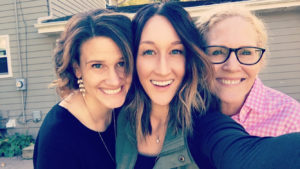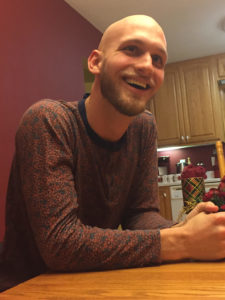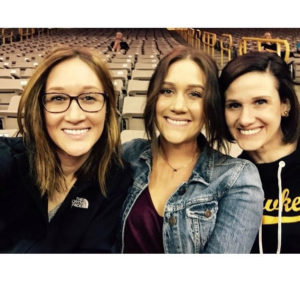By Julie Kennedy

Thirty years ago, my family began the journey called, “life with ectodermal dysplasia.” We didn’t know it at the time, but my husband had tooth and nail syndrome. Many in his family had it, but it was just shrugged off as weird shaped and missing teeth, a “Kennedy Thing.” It was not discussed so my husband and I were truly in the dark.
Our Daughter
When our first daughter’s teeth started to come in, pegged shaped and many not coming in at all, we were assured by our much loved but not a well-informed dentist that she was fine. I was in nursing school at the time. A geneticist from the University of Iowa came and spoke to our class. The last thing she touched on were rare disorders involving missing and pegged shaped teeth. It was then that I began to learn about ectodermal dysplasia.
I called the National Foundation for Ectodermal Dysplasias (NFED). They were absolutely instrumental in the beautiful outcomes that my now grown children have experienced. Among many things, they gave me information on obtaining insurance coverage. I fought and my hospital covered all of their treatments under their medical plan. This was easily $100,000 per child – temporary partials, braces, implants, crowns, bridges, bone grafting, etc. Four of our five children are affected.
The NFED is Invaluable

The wealth of information and support the NFED supplies are invaluable. They assisted me in finding the correct dentists, oral surgeons, and prosthodontists who dealt with ectodermal dysplasia. They also gave me information about the psychological and social impacts.
Even in our own family, I was chastised for “opening a can of worms” when I looked into this “Kennedy teeth thing.” Now, I have been able to help the next generations who have been affected. Knowledge really is power.
I can not overstate the importance of talented and knowledgeable providers to obtain a beautiful restoration. The NFED gave us the tools to understand ectodermal dysplasia and find treatment teams.
Truly said, my kids couldn’t smile without the NFED!

I would love to get in touch with this adorable family! just found out yesterday that my daughter has ectodermal dysplasia! I would love to chat with your adorable family ❤
I, at age 53 have just found out I suffer from Ectodermal Dysplasia. I have blindness in my right eye. I have always had corrective lenses. I have a severe case of missing/mis-shapen teeth. I had no idea there was a name for this until now. I’m having dental/oral problems now. The treatment plan is exorbitant, I don’t know how I’ll pay. Is there help for adults?
Hi, Lynn. We are glad that you found your way to the National Foundation for Ectodermal Dysplasias (NFED). We welcome you to our community! We are glad to hear that you have finally found a diagnosis. You can visit https://nfed.org/treat/ to learn about the various programs we offer regarding help with treatment. Also, I encourage you to fill out t his form, if you have not already done so: https://nfed.org/join-us/. We have lots of information and support for you. Finally, I encourage you to call our office and talk to Kelley on our staff. She can listen, talk with you about your question and provide information. We look forward to hearing from you! ~ Jodi Edgar Reinhardt, NFED Director, Marketing and Communications
Hello.
Myself and my two boys both have extidermal dysplasia. I’m just curious what dentist you used as I don’t find that we get much help or that they have much knowledge of this condition where we are. Myself I am missing 7 teeth. My eldest son is missing all of his front teeth and only has his molars. He will be 15 and my youngest appears to be missing the same as me thus far (he is only 2). My daughter, who is 12 was tested and does not have ED.
This is something I also got from my dad family something they never spoke about either. My dad as one of his cousins have it. No one else seems too. Of my dads 4 Daughters it looks like 3 of us have it. Too early to tell if any of my nieces and nephews will have ED.
Hi, Jessica. Thank you for sharing about your family. Finding a dentist can be tough and frustrating. Often, you are the one who has educate them about your rare disorder. We have several resources that might help you in finding a dentist to help you. Here’s one: https://nfed.org/blog/tips-for-finding-a-doctor-or-dentist/. That article is filled with ideas to help you. Here’s an article about how to choose a doc/dentist: https://nfed.org/treat/choosing-doctor-dentist/. If you still need help, don’t hesitate to reach out to us at the office at 618-566-2020. We are happy to help. Also, have you filled out the form at https://nfed.org/join-us/? By doing so, we can send you some great information. Thanks! Jodi, NFED, Director, Marketing and Communication
Hi! Sorry about the very late reply! I didn’t know about comments! We started with Chris Haganman in Cedar Rapids, IA. He is a wonderfully talented prosthodontist ( tooth maker).
I also meant to also say that a wonderful general dentist who can hook you up with all the right specialists is Dr James Skvor in Coralville, IA. He is very very familiar with ectodermal dysplasia and would know exactly who you needed to see and where to start.
Hi, Julie! Thanks for following up with a great reference. ~ Jodi, NFED, Director, Marketing and Communications
Do you only help with ectodermal dysplasia? My daughter is missing 6 adult teeth, and I am guessing this would be considered non-syndromal oligodontia. She does not seem to have traditional symptoms. She does have Hashimoto’s thyroiditis, moderate asthma, and eczema. She is 15 and I’m gearing up to fight insurance to cover orthodontics.
Hi, Elena. Yes, we only provide services for ectodermal dysplasia. That said, we encourage you to call our office and talk to Kelley at 618-566-2020 to further discuss if your daughter could have a form of ectodermal dysplasia. We do have an insurance toolkit that could be helpful for you. While it’s geared to ectodermal dysplasia, it may have tips that you could apply to your situation. Learn more here: https://nfed.org/treat/insurance-assistance-program/. Hope this helps! ~ Jodi, NFED, Director of Marketing and Communications